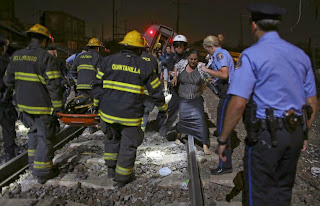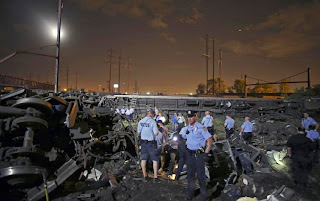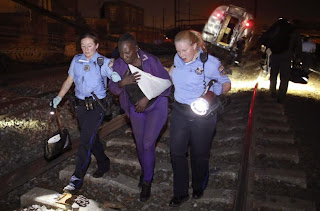Emergency workers look through the remains of a derailed
Amtrak train in Philadelphia, Pennsylvania May 13, 2015. REUTERS
MAY 17, 2015
WASHINGTON, DC
For the first time, Amtrak could face a $200 million payout
to train crash victims - the limit set by Congress. But that may be too low to
cover the costs of the eight lives lost and more than 200 people injured in
last week's derailment in Philadelphia.
That payout cap for a single passenger rail incident was
part of a late effort in 1997 to pass a law that would rescue Amtrak from
financial ruin and help it one day become independent.
Amtrak crash prompts regulators to order safety measures.
Adjusted for inflation, which the law does not consider,
that amount would be just under $300 million now. And Amtrak is still far from
independent.
An Associated Press review of past cases found that Amtrak
never before has been liable for a $200 million payout for a single passenger
rail incident. The Philadelphia crash could be the first time the liability
ceiling - designed specifically for Amtrak - would actually apply to the
railroad.
It's not known how high the costs of victims' deaths and
injuries from Tuesday's crash will run.
Federal investigators have said the train wasbarreling
through the city at 106 mph before it ran off the rails along a big curve where
the speed limit drops to 50 mph. But they don't know why it was going so fast.
The National Transportation Safety Board has said a
projectile appears to have hit the windshield before it derailed Tuesday night,
killing eight passengers and severely injuring dozens.
The train's engineer, Brandon Bostian, has said he doesn't
remember the moments before the crash.
Derailed Amtrak train sped up in minute before crash
On Friday, an Amtrak employee filed the first lawsuit,
asking for more than $150,000 in damages. Amtrak employees are not limited by
the $200 million cap because it only applies to passengers.
"I don't think Amtrak has ever faced a situation like
this, and since they own the Northeast Corridor, they're 100 percent on the
hook," said Frank Wilner, author of the book, "Amtrak: Past, Present,
Future."
Using past passenger rail accidents as a guide, some lawyers
expect damages from the crash to be similar to a 2008 accident in Los Angeles,
which resulted in a $200 million payout to victims. In that crash, the train's
engineer was texting and didn't stop at a red signal when the train collided
head-on with a freight train, killing 25 people and injuring more than 100.
The money was paid to victims by Metrolink, which provides
commuter rail service in Southern California, and Veolia Environment, a French
company that operated the rail service at the time.
A judge divided the $200 million among the victims, with
sums between $12,000 and $9 million. In some cases, lawyers said the amounts
were far less than the projected costs of medical care needed as a result of
the crash.
Push to improve automated safety on U.S. trains
Paul Kiesel, a Los Angeles attorney who represented victims
from the 2008 crash, said $200 million "can be just a drop in a bucket to
compensate people who are the victims of passenger rail collisions in
America."
But Kiesel said he is not aware of another passenger rail
incident in which the $200 million cap has been a factor.
Amtrak spokesman Marc Magliari said he was unable to say
whether Amtrak had ever paid $200 million in damages for a single passenger
rail incident.
It's difficult to put a price on a person's life, said
Howard Spier, a Miami-based lawyer and former president of the Academy of Rail
Labor Attorneys. But the people traveling on the Amtrak train that crashed last
week are typically successful, he said.
"The more you've got going on in your life, the more
your damages are worth," Spier said.
Though passenger rail crashes that lead to $200 million
victim settlements have been rare in America, liability has long been a
concern.
"Limits on liability are essential for our economic
future," former Amtrak president Tom Downs told Congress in 1996.
Investigators learn new details surrounding deadly
derailment
In 1997, the year the liability cap was passed, Amtrak faced
bankruptcy, and Congress had been trying for three years to come up with a plan
to turn the struggling rail line into a profitable company without government
subsidies.
Among issues challenging Amtrak financially were liability
for all accidents involving Amtrak, even if they weren't Amtrak's fault.
Establishing a cap on damages would help Amtrak purchase insurance at a
reasonable cost.
At the time, Amtrak had about $200 million in liability
insurance, government auditors said in a 1995 report. It was facing lawsuits
totaling more than $200 million for a range of incidents.
A $200 million limit on liability for passenger rail
accidents was added to a compromise bill at the end of the debates.
"That is what we are trying to do, is have some sort of
quantifiable limit so we will know what the costs would be in the most extreme
circumstances," then-Sen. Kay Bailey Hutchinson, R-Texas, said on the
Senate floor.
Democrats supported the $200 million cap, too.
"Amtrak passengers will have to bear a limit on
Amtrak's liability to them, much the same way that the airlines limit their
liability to passengers," said then-Sen. Earnest Hollings, D-S.C.
Airlines do have a cap, but it's not the same as what
Congress created for passenger railroads.
An international aviation convention established a
per-passenger cap on damages at about $160,000. If an airline is proved
negligent in court, victims' families can sue for more, unlike the families of
passenger rail victims.
In 2010, some California lawmakers moved to increase the cap
to $500 million, but the rail industry successfully lobbied against the
measure.
"Now you have people with serious injuries that may not
be compensated from Amtrak for all their losses," said Connecticut
attorney George Cahill, who is representing one of the passengers injured in
the May 12 crash.
Source:www.cbsnews.com

















































